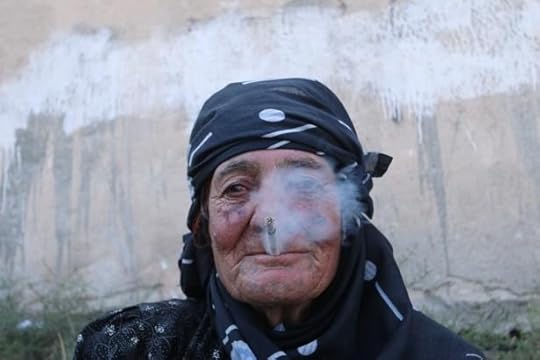Atlantic Monthly Contributors's Blog, page 100
August 14, 2016
The Killing of a New York Imam

NEWS BRIEF An imam and a friend were shot to death Saturday afternoon in New York City after leaving a prayer session at a nearby mosque, police said.
The imam, Maulama Akonjee, 55, and Thara Uddin, 64, were both shot in the head as they walked from Al-Furqan Jame Mosque, about one to two blocks away, according to ABC News. The men were transported to a nearby hospital, where they later died, CNN reported Sunday, citing New York police.
The shooting occurred in broad daylight in Ozone Park, a neighborhood in Queens, shortly before 2 p.m. Police have released a sketch of the suspect, who remains at large. They have not yet released a motive for the crime, but say preliminary evidence does not suggest the men were targeted because they were Muslim.
More from CNN on the scene in Ozone Park:
Nazim Uddin, a neighbor of the imam, told CNN he ran outside from his home when he heard gunfire. He remembered the imam as a good man who only a day earlier had delivered a eulogy at the mosque.
On Saturday evening, dozens of residents, mostly men, gathered under elevated train tracks waving signs and chanting, “We want justice!”
The imam’s daughter, Naima Akonjee, told the AP Saturday her father and Uddin “were close friends who always walked together to the mosque from their homes on the same street.”

August 13, 2016
The Stabbings on a Swiss Train

A man armed with a knife and a flammable liquid stabbed six people, including a six-year-old child, aboard a Swiss train, police in St. Gallen Canton said Saturday.
The train was traveling between Buchs and Sennwald, and the attack occurred shortly before the train entered Salez station, police said in a statement.
“According to current information a 27-year-old Swiss man poured out a flammable liquid,” the statement said. “He was also armed with at least one knife. The liquid caught fire.”
The attacker was also injured; his victims were three adults, aged 34, 43, and 50; two 17-year-olds; and the six-year-old. All had stab and burn injuries, police said.
No motive has yet been ascribed to the attack, which police continue to investigate; a criminal investigation has been opened, police said.
It is the first attack of this nature in Switzerland in recent times. Concerns over similar attacks in Europe, including a recent stabbing spree aboard a train in Germany, as well as terrorist attacks claimed by ISIS in France and Belgium, have prompted fears across the region.

Kenny Baker (1934-2016)

Kenny Baker, the actor perhaps best known for playing R2-D2 in the Star Wars films, has died following a long illness, his niece told The Guardian. Baker was 81, according to the birthdate on his official website. Other news reports said he was 83.
“It was expected, but it’s sad nonetheless,” Abigail Shield told the newspaper Saturday. “He had a very long and fulfilled life. He brought lots of happiness to people and we’ll be celebrating the fact that he was well loved throughout the world. We’re all very proud of what he achieved in his lifetime.”
Baker, who was 3-feet, 8-inches tall, portrayed R2-D2, in the first of the Star Wars movies in 1977. The movie catapulted the character—and Baker—to international fame. Baker went onto star as R2-D2 in the next five Star Wars movies, and was listed as a consultant on The Force Awakens. He also appeared in Terry Gilliam’s Time Bandits (1981), and Neil Jordan’s Mona Lisa (1986). But it was Star Wars, and his partnership with Anthony Daniels, who played R2-D2s companion, C-3PO, for which the U.K.-born actor is perhaps best known—despite his ambivalence for the role and his often-tense relationship with Daniels.
Born in Birmingham on August 24, 1934, his website says, Baker began performing in 1950 with the Burton Lester’s Midgets. He also worked as a DJ, a clown, and a shadow ringmaster. He was married to the actress Eileen Baker from 1970 until her death in 1993.
Star Wars fans paid tribute to the actor. This perhaps sums up what many of us feel:
— Bryant Francis (@RBryant2012) August 13, 2016

Fidel Castro's 90th Birthday Message

Former Cuban President Fidel Castro, in a letter published Saturday to mark his 90th birthday, thanked his people, and criticized President Obama for not apologizing to the Japanese people during the American leader’s visit to Hiroshima.
Castro, who led Cuba from 1959 when his Communist rebels toppled the regime of then-dictator Fulgencio Batista, until 2008 when he stepped down due to ill health, reminisced about his childhood in Biran, in eastern Cuba, and described the region’s vegetation and geology.
“I wish to express my deepest gratitude for the signs of respect, greetings, and gifts I have received in these days, that give me strength to reciprocate through ideas that I will send to party militants and relevant organizations,” he wrote.
Castro, who came to power in the Eisenhower era, has outlasted U.S.-backed plots against him, as well as several American presidencies. Under him, Cuba adopted a socialist economic model that suffered when its benefactor, the Soviet Union, collapsed in the early 1990s. Castro’s Cuba saw dramatic improvements in health and other human-development indicators, but dissent was crushed, and his regime was severely criticized for its poor human-rights record.
Castro stepped down in February 2008 amid a gastrointestinal illness, and has been reported close to death or dead on several occasions since then. In his letter Saturday, he alluded to the modern medicines thad had kept him alive.
“Modern technologies,” he wrote, “have allowed me to scrutinize the universe.”
The Associated Press has more on the Cuban government’s celebration of Castro’s birthday:
The Cuban government has taken a relatively low-key approach to Castro's birthday, in comparison with the large-scale gatherings that had been planned for his 80th. Government ministries have held small musical performances and photo exhibitions that pay tribute to the former head of state. On Saturday morning, state media showed images of Venezuelan President Nicolas Maduro arriving in Havana and a tribute was planned at a Havana theater Sunday evening. The government did not say which Cuban officials would attend.
Castro last appeared in public in April, closing the twice-a-decade congress of the Cuban Communist Party with a call for Cuba to stick to its socialist ideals amid ongoing normalization with the U.S.
Castro was succeeded in 2008 by his brother Raul Castro, who opened up the country’s economy, and undertook a historic rapprochement, brokered by Pope Francis, with the U.S. Obama visited Cuba in March, a trip that was unimaginable when Fidel Castro was in power. Indeed, after Obama’s trip, Castro wrote a scathing letter, criticizing the American president’s remarks urging Cubans to look to the future. “We don’t need the empire to give us anything,” Castro wrote at the time.
In his letter Saturday, he criticized Obama once again, saying the U.S. president should have apologized to the Japanese public during his visit to Hiroshima in May. He said Obama’s lack of an apology “lacked stature.”

What Happens When a Town Is Liberated From ISIS

Men got haircuts and shaved their beards. Women lit up cigarettes and burned their niqabs. Residents of Manbij, Syria, who had lived under the Islamic State for nearly two years, came out onto the streets and celebrated, shedding tears of joy.
“May God destroy them. They slaughtered us,” a young man shouted in a square in Manbij. “May they not live for a minute.”
“I feel joy and [it is like a] dream I am dreaming,” a woman said, according to Reuters. “I cannot believe it, I cannot believe it. Things I saw, no one saw,” She then fainted, the news agency said.
Fighters from the U.S.-backed Syria Democratic Forces (SDF) recaptured Manbij, Aleppo province, on Friday after more than 70 days of intense fighting against ISIS, which seized the northern town about two years ago. SDF fighters, mostly Kurds and Arabs, and including women, freed more than 2,000 civilians who’d been taken hostage by the extremists.
The SDF is “in full control” of Manbij, Nasser Haj Mansour, a fighter with the group, told The Associated Press. Another rebel leader told Reuters they were still looking for possible ISIS sleeper cells in the town, which is near the border with Turkey.
The loss of the town is a major blow to the Islamic State because the group’s supply route from Raqqa, its de facto capital, and Turkey, is essentially cut off. Gordon Trowbridge, the Pentagon deputy spokesman, called Manbij’s loss “a major setback for” ISIS. NBC adds:
The Manbij operation, in which U.S. special forces have played a significant role on the ground, marks the most ambitious advance by the Washington-allied SDF since the U.S. launched its military campaign against ISIS two years ago.
U.S. officials have said once the Manbij operation is completed, it would create the conditions to move on the militant group's de facto capital of Raqqa, Reuters reported. U.S. officials anticipate a tough battle.
But while the U.S. and its allies prepare for that tough battle, resident of Manbij will likely return to a state of relative normalcy that existed before ISIS captured the town.

Ghostbusters and Barbershops: The Week in Pop-Culture Writing

Ghosts From Our Past: Both Literally and Figuratively
Elif Batuman | The New Yorker
“If the original Ghostbusters was about the thrill of the free market, the new one is about its consequences—about the people it disenfranchises, and the possibility that they will try to take violent retribution. To get anything, in the new New York, you have to take it from someone else.”
Goodbye to the Barbershop?
Kristen Barber |The Conversation
“In some white gentrifying neighborhoods, the barbershop is actually making a comeback. These new barbershops primarily act as places where men can channel a form of masculinity that supposedly existed unfettered in the ‘good old days.’ Sensory pleasures are central to the experience: The smell of talcum powder, the cool burn of aftershave and the site of shaving mugs help men to grapple with what it means to be a man at a time when traditional definitions of masculinity are in flux.”
Nickelodeon Grew Up and Blew Up in 1996
Erik Adams | A.V Club
“On Kenan & Kel, anarchy reigned within the confines of an old-fashioned sitcom. Like Pete And Pete and Doug before it, Hey Arnold! was reverent toward the mysteries and joys of youth, but also aware of its profound melancholy. Before Blue’s Clues conquered the world and spawned an undying urban myth, it channeled the spirit of every great Nickelodeon production: play.”
Meet Lil Uzi Vert, The First Rockstar of Post-Obama Rap
Jason Parham | The Fader
“You know it when you hear it: the seesawing beats; the gliding hooks that feel like they’re rising out of some dark, hazy hell; the erupting bursts of lyricism that twist and turn before suddenly dissolving; the tales of endless nights and lost loves and unpardonable fuck-ups. Uzi has a wunderkind-like proficiency for this particular style, and he knows it.”
Did Fast and Furious Star The Rock Just Hand Vin Diesel His Candy Ass?
Marina Hyde | The Guardian
“I can’t even imagine the strain of living in that type of paranoia-inducing closed environment, let alone shooting a scene where a car has to head-butt a Chinook, and you daren’t even ask what your motivation for screaming NOOOOOOOOOO is, in case you’re being scoped. That set can have been nothing less than the panopticon of candyassery.”
Teju Cole’s Essays Build Connections Between African and Western Art
Claudia Rankine | The New York Times
“[Cole] lays bear the relationship among sentimentality, ignorance, corruption, pillage and complicity within our global communities. Under Cole’s watchful eye the world shrinks into a network of countries, communities, and individuals influenced by, dependent on, and affected by other countries, communities, and individuals.”
Is Andre Ward the Last Great African American Boxer?
Sunni Khalid | The Undefeated
“The confusing alphabet soup of more than a half-dozen rival sanctioning bodies, each with its own title and divisional rankings, has diminished the title of champion. Ironically, it is the mythical ranking of the best boxer, pound-for-pound, that carries the most relevance. By whatever metric, it is clear that change is here.”
No More Good Time in the World For Me
Max Nelson | The Paris Review
“One can imagine younger prisoners wanting to repudiate the music of their predecessors, but it’s also not hard to imagine that the songs themselves might have struck younger black prisoners in the sixties as defeatist or resigned. ‘The songs,’ Jackson wrote in the introduction to Wake Up Dead Man, ‘concentrate on the devices and forms of control, and the manifestations of impotence. The language of the songs is highly concrete, but the themes are not; the themes are negatives: things like unlove and unfreedom and unimportance.’”
Stranger Things, Ghostbusters, and the Value of Less Advance Hype
Jen Chaney | Vulture
“In the age of overhyped everything—from tentpole movies to second seasons of HBO series—there is something satisfying about finding a piece of pop culture that’s intended for mainstream consumption but somehow hasn’t been discovered yet. Our culture and certainly our media outlets, including this one, are super-thirsty at all times for information. Studios, creators, and marketers of films and TV shows are constantly figuring out how to feed the beast in a way that keeps their projects at the front of consumers’ minds.”
Nonsense, Cartoons, and My Post-Soviet Adolescence
Naré Navasardyan | Electric Literature
“Apparently, my favorite childhood cartoon involved a manic, suicidal chain-smoking screenwriter; a pill-abusing film director; endless bureaucratic delays; the most obnoxious girl actress in the animated world; and a finale in which the entire crew weeps over their reward, a scrawny and unsightly bouquet. Once again the intended message is clear: filmmaking, as with much else in life, is a great deal of hard work in return for the superficial prize of fleeting applause.”

The Cultural Allure of Bank Robbers

Banks make really good bad guys. As cinema has shuffled through a lineup of antagonists including Nazis, Russians, clowns, and robots, banks have had remarkable staying power as one of Hollywood’s truly unambiguous forces for evil. The status of financial institutions as villains is backed up by society: people don’t trust them. Even when bankers are the primary characters in movies, as they are in Wall Street and The Wolf of Wall Street, we watch and await their inevitable schadenfreudian demise.
The mistrust is such that movies featuring banks and bankers as villains can get away with having morally complex antiheroes or straight-up murderous thieves as heroes. Sometimes it’s cool to root for murderers. It’s never been uncool to root against banks.
The anti-bank trope is particularly common in heist films like Spike Lee’s Inside Man and Michael Mann’s Heat, both of which featured likable and even lovable bank-robbing characters. It was already well established by the time Butch Cassidy and the Sundance Kid escaped to Bolivia and robbed banks. But in today’s world, where banks have taken a much clearer step into real-life villainy after the Great Recession, films like the new release Hell or High Water, directed by David Mackenzie and written by Taylor Sheridan (Sicario), place them as chief among a constellation of modern anxieties.
The marketing for Hell or High Water has made efforts to link the movie’s themes to the present-day anxieties about the economy that fueled Senator Bernie Sanders’s campaign until recently, and—in a different way—Donald Trump’s. The film itself is subtler; not much more happens on-screen than a very straightforward attempt by two brothers, played by Chris Pine and Ben Foster, to knock off the banks that knocked them off. But there’s subtext among its wide, dusty shots of open road, rocky red buttes, and a contemporary western depiction of what Sheridan calls the “modern frontier.” The movie reveals towns taken over and choked by oil, prospectors, and banks; eroding environments; cycles of simmering racial struggles—from the original slaughter of Plains Indians people to new tensions between white residents and Spanish-speaking immigrants—and a depiction of southwestern open-carry gun culture that seems almost like a caricature.
Those threads of societal fears played out similarly in Sheridan’s past film, Sicario, which featured a look into the tangled web of corruption, violence, and racial issues on the Mexican border. In Sicario, a kind of brutality that we like to think belongs to the past or to other places is regurgitated on people on either side of border, manifesting in a war that regular people often get caught up in. That film’s cartel villains also represented present-day worries, and the frontier setting was a tapestry upon which to show exactly how American fears develop.
For Sheridan, it’s all part of the plan. “When I started writing Sicario, my plan was to do this sort of thematic trilogy on the modern American frontier and how much it changed and didn’t change,” he told me. “What were the consequences of actions a century ago today? So Sicario was my first venture into that, Hell or High Water was second, and Wind River [Sheridan’s 2017 directorial debut] is the conclusion.”
The fact that banks are the villain in Hell or High Water reinforces Sheridan’s desire to depict the cyclical ironies of Americanness.
There are no plot connections between the three films, but it’s clear that Sheridan is looking to dig into recurring themes of the less glamorous bits of Americana. The reason so much of the clichéd parts of the American identity were developed and honed on the frontier is the same reason why the worst parts of it manifest so often there. “I live in the West and see all these consequences today that were forged 130 years ago,” Sheridan said.
The fact that banks are the villain in Hell or High Water reinforces Sheridan’s desire to depict the cyclical ironies of Americanness. Once it was white settlers, cowboys, prospectors, and oil magnates who prowled the Southwest, killing and swindling native inhabitants in one of the greatest land-grabs the world has ever seen. But now the descendants of many of those white settlers find themselves losing their land to Big Oil and to Wall Street, and they struggle to maintain or regain their status in two classic ways.
On one side are people who aspire to be literal or political Robin Hoods, banding together with other wronged groups to take from the rich and redistribute to the poor. On the other are those who acknowledge that status is relative, and lash out against big business and corruption while also seeking to keep their boots on the necks of immigrants or other minorities. Throughout Hell or High Water and to a lesser extent, Sicario, these are the dilemmas that white characters on the old and new frontier face. “A way of life is fading,” Sheridan told me, “just like the way of life for Plains Indians was fading them. There’s a cyclical nature to it that I think was worth writing about.”
As the anxieties of poor and working-class white people help define the shape of American politics, they show up in Hell or High Water in both forms. The banks are universal—they’ve screwed everyone regardless of race—but tensions with other people show themselves too. Jeff Bridge’s character Marcus, a Texas Marshal, launches salvo after salvo of racism against his partner Alberto, played by Gil Birmingham. In a string of towns ruled by those tensions between in-groups and out-groups, the religious adherence to gun culture begins to make sense. There, it’s us or them.
But, as has always been the case for the West as a movie setting, it’s not just there. The West is here, and a crumbling sense of unity and omnipresent threat of violence afflict not only sparse towns in Texas and Oklahoma, but the most vibrant and ugly bits of dense urban America. Banks make sense as a villain, and still tend to unite most people politically because of the fear deep down that the only other enemy worth fighting is each other.

August 12, 2016
Striking ISIS

A U.S. airstrike last month in the southern Afghan province of Nangarhar killed Hafiz Sayed Khan, the ISIS leader in the country.
Gordon Trowbridge, the deputy press secretary at the U.S. Defense Department, said a U.S. airstrike on July 26 killed Khan in Achin district.
“Khan was known to directly participate in attacks against U.S. and coalition forces,” Trowbridge said, “and the actions of his network terrorized Afghans, especially in Nangarhar.”
Earlier, Omar Zakhilwal, the Afghan ambassador to Pakistan, told Reuters the strike killed several other senior ISIS fighters. A similar claim about Khan’s death last year was not confirmed.
Khan’s death is a blow to ISIS, which has made inroads in Afghanistan. The group has also suffered major setbacks in its strongholds of Iraq and Syria, but has carried out directly or inspired terrorist attacks across Europe and the U.S.

Making a Free Man

NEWS BRIEF A federal judge in Milwaukee overturned Friday the murder conviction of Brendan Dassey, who was convicted as a teenager of killing Teresa Halbach, and whose case was the subject of the Netflix show Making a Murderer.
Brendan Dassey must be released from custody in 90 days, unless the State wants to retry him #MakingAMurderer pic.twitter.com/FPppy7rR91
— Mike Hayes (@michaelhayes) August 12, 2016
John Diedrich, a reporter with the Milwaukee Journal-Sentinel, reported that the federal judge in the case called the actions by Dassey’s attorney “indefensible.”
Judge: Repeated false promises ... Dassey's age, intellectual deficits ..absence ofsupportive adult, rendered confession involuntary
— John Diedrich (@john_diedrich) August 12, 2016
The Netflix series Making a Murderer describes the story of Steven Avery and Dassey, Avery’s nephew. They were both convicted in 2005 for Halbach’s murder, and are serving life sentences.

The Atlantic's Week in Culture

Don’t Miss
Hollywood Has Ruined Method Acting—Angelica Jade Bastién traces the history and identity politics of a technique that has become so popular among (primarily) the industry’s leading men.

David Gray / Reuters
Sports
The Glorious Drama of the U.S. Swim Team—Sophie Gilbert relishes the poolside antics that put Hollywood scriptwriters to shame.
The Singular Joys of Watching Ichiro—Robert O’Connell pinpoints the simple elegance of watching the newest member of baseball’s 3,000 hit club.
Their Bodies, Ourselves—Megan Garber identifies the fine balance between femininity and athleticism in women’s gymnastics.
Women’s Softball Needs the Olympics—Chelsea Leigh Horne explains how the sport’s reinstatement for Tokyo 2020 is a significant victory for gender equality in athletics.
The Real Olympic Challenge for American Basketball—Robert O’Connell declares that the perpetual gold-medal favorites are determined to prove they can’t lose.
The 27 Hugs You Meet in Rio—Megan Garber breaks down the various kinds of embraces viewers are bound to see at the Olympics.
The Olympic Quote (That Should Be) Heard ‘Round The World—Megan Garber exposes the gendered double-standards that lurk behind the media’s coverage of female athletes in Rio.

HBO
Film
Hitchcock/Truffaut Is a Master Class in Cinema—David Sims reviews a new HBO documentary based on the now-historic conversation between two of film’s greatest minds.
Hell or High Water Offers and Iconic Vision of the Modern West—Christopher Orr reviews the stunning new neo-Western that will make viewers love West Texas.
The Reason Suicide Squad is Crushing? Fans Love It—Andrew McGill dives into the data behind superhero movies to figure out why DC’s newest “flop” is actually doing so well at the box office.

NBC
Television
Why Saturday Night Live Shook Things Up—David Sims makes sense of what’s going on behind the scenes of the show’s revamping efforts.
Next Season, Let Unreal’s Master Manipulators Free—Spencer Kornhaber unpacks the finale of the show’s second season, and speculates on what season three might have to offer.
Martha Stewart, Queen of All Internet—Megan Garber analyzes the brand transformation of the “domestic diva” in the wake of her upcoming cooking show with Snoop Dogg.
What’s Wrong With Mr. Robot—Lenika Cruz answers some of the questions hanging over the hit USA show’s shaky second season.
The Get Down and the Sanctuary of Hip-Hop—Spencer Kornhaber details how Netflix’s newest show handles the music and dangers of real life in the Bronx of the ’70s.

Norsk Telegrambyra AS / Reuters
Music
Frank Ocean, Harper Lee, and the Reclusive Artist—Eve L. Ewing explores the links between the two brilliant, quiet artists and the masterpieces they’re known for.
Frank Ocean Is Working on His Own Terms—Spencer Kornhaber argues that the singer continues to stand for the ideal of the artist fully in charge of his art.
And the Gold Medal in Olympic Music Marketing Goes To …—Spencer Kornhaber looks at some of the stars who’ve taken on the inspirational-song format during this year’s games.
Parsing Obama’s Sexy, Sometimes Woke Summer Playlist—David Graham combs through the president’s rather sensual, seasonal jams.

Hello Games
Video Games
The Infinite Possibility of No Man’s Sky—David Sims explores the colossal universe of the highly anticipated new game.

Brian Snyder / Reuters
Media
Slightly More Than 100 Exceptional Works of Journalism—Conor Friedersdorf returns with his annual list of the best nonfiction writing from 2015.

Atlantic Monthly Contributors's Blog
- Atlantic Monthly Contributors's profile
- 1 follower



